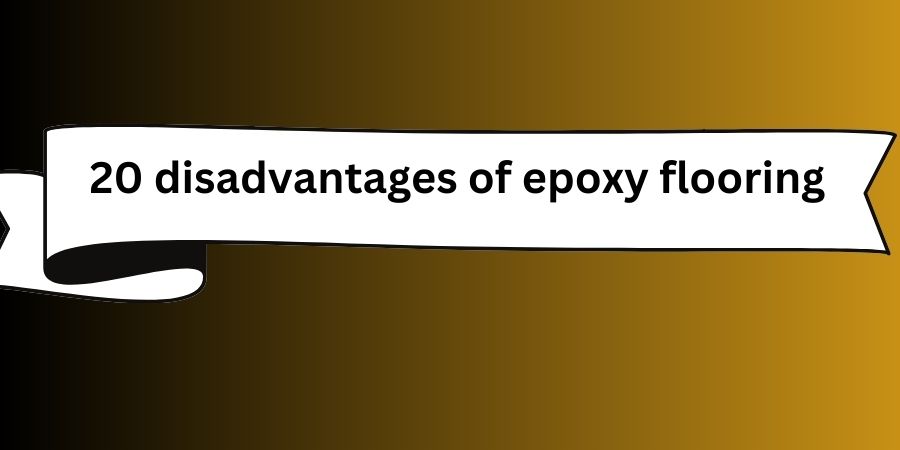Epoxy flooring is a type of flooring that’s made from a combination of resins and hardeners.
It’s often used in industrial or commercial settings, but it’s also becoming increasingly popular in homes as well. Known for its durability, resistance to chemicals and abrasion, and its ability to create a seamless, high-gloss surface.
It’s available in a wide range of colors and styles, making it a versatile flooring option that can be customized to fit almost any design aesthetic.
However, while epoxy flooring has many benefits, it’s important to be aware of its potential disadvantages as well.
20 Disadvantages of expoxy flooring
Slippery Surface:
If you’re considering epoxy flooring, keep in mind that it can create a surface that’s quite slippery, which can be dangerous for people walking or working on it.
Requires Skilled Installation:
When it comes to epoxy flooring, it’s important to have a skilled professional install it for you. Without the right installation, you may end up with an uneven surface, bubbles, or cracks.
High Cost:
One downside to epoxy flooring is that it can be pretty expensive, especially if you hire a professional to install it for you. The cost can vary depending on the size of the area and the quality of the materials used.
Time-Consuming:
Another potential disadvantage of epoxy flooring is that it can be quite time-consuming to install. The process can take several days or even longer, depending on the size of the area and the complexity of the installation.
Prone to Yellowing:
Over time, epoxy flooring can yellow or discolor, especially if it’s exposed to sunlight or other sources of UV light. This can detract from the appearance of the floor and make it look dingy or dirty.
Not Ideal for Moist Environments:
If you’re installing flooring in a damp or moist environment, epoxy may not be the best choice. Moisture can seep into the flooring and cause it to lift or peel over time.
Can Crack Under Heavy Weight:
Epoxy flooring can be quite durable, but it may not be able to withstand very heavy weight. If you’re planning to use the floor for heavy machinery or other weighty items, you may want to consider another type of flooring.
Difficult to Repair:
If your epoxy flooring is damaged, it can be quite difficult to repair. You may need to replace the entire floor or hire a specialist to fix the damaged area, which can be expensive.
Can Emit Harmful Fumes:
When epoxy flooring is installed, it can emit fumes that are harmful to breathe in. This can be a particular concern for people with respiratory issues or allergies.
Not Environmentally Friendly:
If you’re concerned about the environment, you may want to think twice about epoxy flooring. The materials used to create epoxy are not very eco-friendly, and the manufacturing process can be quite resource-intensive.
Limited Color Options:
If you’re looking for a wide range of color options for your flooring, epoxy may not be the best choice. While there are some color options available, the selection is often limited.
Can Be Uncomfortable to Stand On:
If you’re going to be standing on your flooring for long periods of time, keep in mind that epoxy can be uncomfortable to stand on. It’s a hard material and doesn’t have much give, which can cause fatigue and discomfort.
Requires Regular Maintenance:
Epoxy flooring requires regular maintenance to keep it looking its best. This can include cleaning, buffing, and resealing, which can be time-consuming and costly.
Limited Texture Options:
If you’re looking for a textured floor, epoxy may not be the best choice. While it’s possible to add texture to epoxy, the options are often limited.
Can Be Noisy:
Epoxy flooring can be quite noisy, especially if you’re using it in a high-traffic area. The hard surface can amplify sound and create an echoey effect.
Can Scratch Easily:
While epoxy flooring is quite durable, it can scratch easily if you’re not careful. This can be a particular concern if you have pets or heavy furniture.
Not Ideal for Outdoor Use:
If you’re planning to install flooring in an outdoor space, epoxy may not be the best choice. It can become discolored over time due to exposure to sunlight and other environmental factors, and it may not be able to withstand the elements as well as other outdoor flooring options.
Limited Durability:
While epoxy flooring is known for its durability, it may not be the best choice for every application. Heavy use, high traffic, and exposure to certain chemicals or environmental factors can cause the flooring to wear down and lose its luster over time.
Can Stain Easily:
Epoxy flooring can be prone to staining, especially if it’s not sealed properly. This can be a particular concern in areas where spills or stains are likely to occur, such as kitchens or garages.
May Require a Long Cure Time:
Finally, it’s important to note that epoxy flooring can take a while to cure. Depending on the type of epoxy used and the conditions in which it’s installed, the flooring may need several days or even weeks to fully cure before it’s ready for use. This can be a major inconvenience for those who need to use the space right away.





